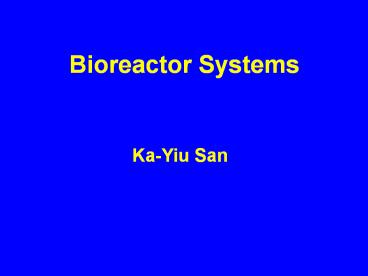Bioreactor Systems - PowerPoint PPT Presentation
Title:
Bioreactor Systems
Description:
Bioreactor Systems Ka-Yiu San Typical ... Mixing pH Dissolved oxygen Temperature pH probe Steam sterilizable Combination electrode Two major types Galvanic ... – PowerPoint PPT presentation
Number of Views:194
Avg rating:3.0/5.0
Title: Bioreactor Systems
1
Bioreactor Systems
Ka-Yiu San
2
A Fermenter / Bioreactor And Its Parts
by Genentech, Corporate Communication
3
(No Transcript)
4
1500L-Scale Bioreactors(courtesy of Tanox )
5
Bioreactor Advantages
- Controlled environment
- Mixing
- pH
- Dissolved oxygen
- Temperature
6
pH probe
- Steam sterilizable
- Combination electrode
Dissolved oxygen probe
- Two major types
- Galvanic
- Polargraphic
7
Galvanic and Polargraphic Probes
Cathode 0.5 O2 H2O 2e- ?
2OH-
Pt
Anode (galvanic) Pb ? Pb2
2e-
Anode (polargraphic) Ag Cl- ?
AgCl e-
8
Mode Batch Fed-batch Continuous (e.g.. chemostat)
9
Batch
Time
10
Fresh nutrient
volume
11
Continuous
Fresh nutrient
cell Spent broth
12
Recombinant processes
- An engineering perspective
13
Cloning for rProtein production
14
Cloning vector properties
- Origin
- Size of backbone
- Well characterized
- Selective marker
- Genetic marker
- Unique restriction sites
15
- Some factors that affect gene expression
- Gene dosage (copy number)
- Plasmid stability (structural and segregational)
- 3. Transcription
- - Promoter and terminator sequences
- (promoter strength, inducible - leakage)
- - Regulatory genes and sequences
- 4. Translation
- - Ribosome binding site (Shine-Delgarno
sequence) - Codon optimization to match host's
codon bias - 5. Final location of gene product
- - Cytoplasmic or extracellular (secreted
out of cell)
16
- Some factors that affect gene expression (contd)
- 6. Protein stability
- - Degradation by host proteases -
Formation of insoluble aggregates - Strain
- Process consideration
- - Medium
- - Temperature (growth vs. production)
- - Dissolved oxygen
- - Induction timing
- - Feeding profile (fed-batch)
- - waste product accumulation
17
Cell Culture
- An engineering perspective
18
Outline
- Examples
19
- Two major classes
- serum supplemented
- serum-free (or low serum)
20
Environment considerations
- nutrient supply
- mixing
- oxygen supply
- pH
- carbon dioxide
- temperature
- waste accumulation
- lactate
- ammonia
21
(No Transcript)
22
Relative specific growth rate
Kolmogorov length scale (microns)
Relative net growth rate versus Kolmogorov eddy
length scale for FS-4 cultures with 0.2 g/l
microcarriers
23
(No Transcript)
24
(No Transcript)
25
(No Transcript)
26
(No Transcript)
27
(No Transcript)
28
(No Transcript)
29
(No Transcript)
30
(No Transcript)
31
(No Transcript)
32
(No Transcript)
33
(No Transcript)
34
(No Transcript)
35
(No Transcript)
36
(No Transcript)
37
(No Transcript)
38
Typical cell growth on microcarriers
39
Typical cell growth on microcarriers
40
Perfusion system - to provide fresh nutrient - to
remove waste (especially toxic byproducts -
mechanical signal
41
(No Transcript)
42
Questions?































